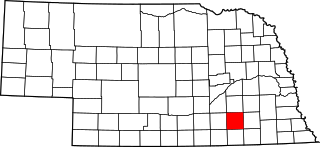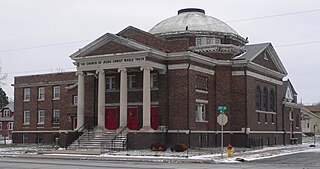Related Research Articles

The XIT Ranch was a cattle ranch in the Texas Panhandle which operated from 1885 to 1912. Comprising over 3,000,000 acres (12,000 km2) of land, it ran for 200 miles (300 km) along the border with New Mexico, varying in width from 20 to 30 miles. The massive ranch stretched through ten counties in Texas and at its peak regularly handled 150,000 head of cattle. The brand "XIT" was chosen for its difficulty to alter thus thwarting rustlers.

Agate Fossil Beds National Monument is a U.S. National Monument near Harrison, Nebraska. The main features of the monument are a valley of the Niobrara River and the fossils found on Carnegie Hill and University Hill.

More than 1,100 properties and districts in Nebraska are on the National Register of Historic Places. Of these, 20 are National Historic Landmarks. There are listings in 90 of the state's 93 counties.

Cattle drives were a major economic activity in the 19th and early 20th century American West, particularly between 1850s and 1910s. In this period, 27 million cattle were driven from Texas to railheads in Kansas, for shipment to stockyards in St. Louis and points east, and direct to Chicago. The long distances covered, the need for periodic rests by riders and animals, and the establishment of railheads led to the development of "cow towns" across the frontier.

The Great Western Cattle Trail is the name used today for a cattle trail established during the late 19th century for moving beef stock and horses to markets in eastern and northern states. It ran west of and roughly parallel to the better known Chisholm Trail into Kansas, reaching an additional major railhead there for shipping beef to Chicago, or longhorns and horses continuing on further north by trail to stock open-range ranches in the Dakotas, Wyoming, Montana in the United States, and Alberta and Saskatchewan in Canada.
The Texas Trail was a cattle drive trail from Texas to Nebraska that was used during the 1870s and 1880s.

Bartlett Richards was a Cattle Baron and Banker who owned or fenced in vast acreage in Wyoming and Nebraska.

This is a list of the National Register of Historic Places listings in Fillmore County, Nebraska.

Walking Box Ranch, 7 mi (11 km) west of Searchlight, Nevada in the Mojave Desert, was founded in 1931 by the actors Rex Bell and Clara Bow as a working 400,000 acres (160,000 ha) ranch. The ranch covered 160 acres (65 ha) at the time it was listed on the National Register of Historic Places on January 30, 2009. The ranch includes four buildings and is owned by the Bureau of Land Management (BLM).

This is a list of the National Register of Historic Places listings in Clay County, Nebraska.

Frederick A. Henninger (1865–1944), commonly known as F. A. Henninger, was a leading architect of Omaha, Nebraska. He was born in 1865 at Albia, Iowa, and attended the Chicago Art Institute. He moved from Chicago to Lincoln, Nebraska, and in 1891 to Omaha. He worked as a draftsman for an architect in 1895 and purchased the practice in 1896. He worked as an architect in Omaha until his retirement in 1937. After retiring, he moved to Pasadena, California and died there in 1944.

This is a list of the National Register of Historic Places listings in Chase County, Nebraska. It is intended to be a complete list of the properties and districts on the National Register of Historic Places in Chase County, Nebraska, United States. The locations of National Register properties and districts for which the latitude and longitude coordinates are included below, may be seen in an online map.

This is a list of the National Register of Historic Places listings in Sioux County, Nebraska. It is intended to be a complete list of the properties and districts on the National Register of Historic Places in Sioux County, Nebraska, United States. The locations of National Register properties and districts for which the latitude and longitude coordinates are included below, may be seen in an online map.

The C.C. Hampton Homestead near Harrisburg, Nebraska, dates from 1890 and is listed on the National Register of Historic Places as a 160-acre (65 ha) historic district. Also known as Warner Ranch, the property included 10 contributing buildings and one other contributing structure.

The Texas Trail Stone Corral, near Imperial, Nebraska, was built in 1874 and is a rare surviving artifact of cattle drives along the Texas Trail. It is listed on the National Register of Historic Places and as a Nebraska historic resource, NeHBS no. CH00-041.
The Sandford Dugout is a dugout house in Sioux County, Nebraska. The house is located 2 miles (3.2 km) west of Nebraska Highway 29 and approximately 25 miles (40 km) north of Mitchell; its exact location is restricted. Pioneer Joseph L. Sandford built the house in 1897 on a homestead claim. His dugout, like most pioneer dugouts, was carved into the side of a hill. Settlers in the Great Plains commonly built dugout houses or sod homes at the time, as more conventional building materials were difficult to obtain in the region. However, the dugouts were usually considered temporary homes and ultimately abandoned; as a result, most of them fell into disrepair, and the Sandford Dugout is likely the only intact dugout remaining in Nebraska. The Sandford property also contained a house, a barn, a well, a privy, and two corrals; these structures have largely been replaced or demolished, and the location of the well and privy are unknown.
A ranch rodeo is a traditional type of rodeo in which teams of cowboys or cowgirls from different ranches compete against each other in events based on the type of work they do every day.
The Kelso Site, near Mullen in Hooker County, Nebraska, United States, was listed on the National Register of Historic Places in 1974.

The JA Ranch is a historic cattle ranch in the Palo Duro Canyon in Armstrong County, Texas. Founded in 1876 by Charles Goodnight and John George Adair, it is the oldest cattle ranching operation in the Texas Panhandle. Its headquarters area was designated a National Historic Landmark in 1960 for its association with Goodnight, one of the most influential cattle barons of the late 19th century. The ranch is an ongoing business, operated by Adair's descendants.
References
- 1 2 "The Texas Trail".
- ↑ Pogany, Erin; Sarah Davis McBride (May 2002). "National Register of Historic Places Registration: Texas Trail Stone Corral / NeHBS # CH00-041" (PDF). Archived from the original on June 16, 2010. Retrieved 2013-02-08.
{{cite journal}}: Cite journal requires|journal=(help)CS1 maint: unfit URL (link) - ↑ "The Texas Trail". Nebraska State Historical Association. Archived from the original on July 2, 2004.
{{cite web}}: CS1 maint: unfit URL (link) - ↑ Haley, J. Evetts (1929). The XIT Ranch of Texas: And the Early Days of the Llano Estacado. Norman: University of Oklahoma Press. p. 126. ISBN 0806114282.